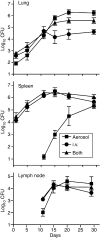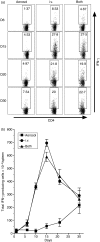'Immunization' against airborne tuberculosis by an earlier primary response to a concurrent intravenous infection
- PMID: 18217954
- PMCID: PMC2492943
- DOI: 10.1111/j.1365-2567.2007.02803.x
'Immunization' against airborne tuberculosis by an earlier primary response to a concurrent intravenous infection
Abstract
Tuberculosis in mice is a lung disease. Airborne infection of this host species with Mycobacterium tuberculosis (Mtb) resulted in 20 days of Mtb growth in the lungs before further growth was inhibited and the level of infection stabilized. Inhibition of Mtb growth was associated with the production of interferon-gamma (IFN-gamma)-producing T cells in the lymph nodes and spleen and with the progressive accumulation of these cells in the lungs. Production of IFN-gamma-producing T cells was not discernable until about day 15 of infection, presumably because Mtb did not disseminate from the lungs to the draining lymph nodes and spleen until after an approximate 10-day delay. By contrast, in mice infected via the intravenous (i.v.) route, the spleen became infected almost immediately, resulting in much earlier production of IFN-gamma-producing T cells and earlier control of spleen and lung infection. In mice infected concurrently via both routes, earlier generation of immunity to the i.v. infection resulted in earlier accumulation of IFN-gamma-producing T cells in the lungs and earlier control of lung infection that was initiated via the airborne route. This protection against airborne infection afforded by an earlier primary immune response is equivalent to that expressed by mice vaccinated with bacillus Calmette-Guérin or certain other vaccines.
Figures





References
-
- North RJ, Jung YJ. Immunity to tuberculosis. Annu Rev Immunol. 2004;22:599–623. - PubMed
-
- Boom WH. The role of T cell subsets in Mycobacterium tuberculosis infection. Infect Agents Dis. 1996;5:3–81. - PubMed
-
- Flynn JL, Chan J. Immunobiology of tuberculosis. Annu Rev Immunol. 2001;19:93–129. - PubMed
-
- Kaufmann SH. How can immunology contribute to the control of tuberculosis? Nat Rev Immunol. 2001;1:20–30. - PubMed
-
- North RJ. Mycobacterium tuberculosis is strikingly more virulent for mice when given via the respiratory than via the intravenous route. J Infect Dis. 1995;172:1550. - PubMed
Publication types
MeSH terms
Substances
Grants and funding
LinkOut - more resources
Full Text Sources
Medical

